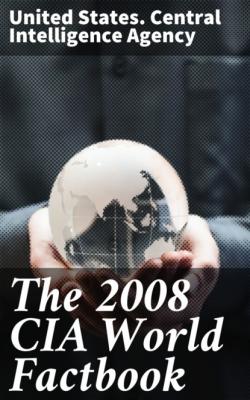The 2008 CIA World Factbook. United States. Central Intelligence Agency
Читать онлайн.| Название | The 2008 CIA World Factbook |
|---|---|
| Автор произведения | United States. Central Intelligence Agency |
| Жанр | Социология |
| Серия | |
| Издательство | Социология |
| Год выпуска | 0 |
| isbn | 4057664638922 |
Natural resources:
coal, iron ore, petroleum, natural gas, mercury, tin, tungsten, antimony, manganese, molybdenum, vanadium, magnetite, aluminum, lead, zinc, uranium, hydropower potential (world's largest)
Land use:
arable land: 14.86% permanent crops: 1.27% other: 83.87% (2005)
Irrigated land:
545,960 sq km (2003)
Total renewable water resources:
2,829.6 cu km (1999)
Freshwater withdrawal (domestic/industrial/agricultural):
total: 549.76 cu km/yr (7%/26%/68%) per capita: 415 cu m/yr (2000)
Natural hazards:
frequent typhoons (about five per year along southern and eastern coasts); damaging floods; tsunamis; earthquakes; droughts; land subsidence
Environment - current issues:
air pollution (greenhouse gases, sulfur dioxide particulates) from reliance on coal produces acid rain; water shortages, particularly in the north; water pollution from untreated wastes; deforestation; estimated loss of one-fifth of agricultural land since 1949 to soil erosion and economic development; desertification; trade in endangered species
Environment - international agreements:
party to: Antarctic-Environmental Protocol, Antarctic Treaty, Biodiversity, Climate Change, Climate Change-Kyoto Protocol, Desertification, Endangered Species, Hazardous Wastes, Law of the Sea, Marine Dumping, Ozone Layer Protection, Ship Pollution, Tropical Timber 83, Tropical Timber 94, Wetlands, Whaling signed, but not ratified: none of the selected agreements
Geography - note:
world's fourth largest country (after Russia, Canada, and US); Mount Everest on the border with Nepal is the world's tallest peak
People
China
Population:
1,330,044,544 (July 2008 est.)
Age structure:
0–14 years: 20.1% (male 142,085,665/female 125,300,391) 15–64 years: 71.9% (male 491,513,378/female 465,020,030) 65 years and over: 8% (male 50,652,480/female 55,472,661) (2008 est.)
Median age:
total: 33.6 years male: 33.1 years female: 34.2 years (2008 est.)
Population growth rate:
0.629% (2008 est.)
Birth rate:
13.71 births/1,000 population (2008 est.)
Death rate:
7.03 deaths/1,000 population (2008 est.)
Net migration rate:
−0.39 migrant(s)/1,000 population (2008 est.)
Sex ratio:
at birth: 1.11 male(s)/female under 15 years: 1.13 male(s)/female 15–64 years: 1.06 male(s)/female 65 years and over: 0.91 male(s)/female total population: 1.06 male(s)/female (2008 est.)
Infant mortality rate:
total: 21.16 deaths/1,000 live births male: 19.43 deaths/1,000 live births female: 23.08 deaths/1,000 live births (2008 est.)
Life expectancy at birth:
total population: 73.18 years male: 71.37 years female: 75.18 years (2008 est.)
Total fertility rate:
1.77 children born/woman (2008 est.)
HIV/AIDS - adult prevalence rate:
0.1% (2003 est.)
HIV/AIDS - people living with HIV/AIDS:
840,000 (2003 est.)
HIV/AIDS - deaths:
44,000 (2003 est.)
Major infectious diseases:
degree of risk: intermediate food or waterborne diseases: bacterial diarrhea, hepatitis A, and typhoid fever vectorborne diseases: Crimean Congo hemorrhagic fever, Japanese encephalitis, and malaria water contact disease: leptospirosis animal contact disease: rabies note: highly pathogenic H5N1 avian influenza has been identified in this country; it poses a negligible risk with extremely rare cases possible among US citizens who have close contact with birds (2008)
Nationality:
noun: Chinese (singular and plural) adjective: Chinese
Ethnic groups:
Han Chinese 91.5%, Zhuang, Manchu, Hui, Miao, Uyghur, Tujia, Yi, Mongol, Tibetan, Buyi, Dong, Yao, Korean, and other nationalities 8.5% (2000 census)
Religions:
Daoist (Taoist), Buddhist, Christian 3%-4%, Muslim 1%-2% note: officially atheist (2002 est.)
Languages:
Standard Chinese or Mandarin (Putonghua, based on the Beijing dialect), Yue (Cantonese), Wu (Shanghainese), Minbei (Fuzhou), Minnan (Hokkien-Taiwanese), Xiang, Gan, Hakka dialects, minority languages (see Ethnic groups entry)
Literacy:
definition: age 15 and over can read and write total population: 90.9% male: 95.1% female: 86.5% (2000 census)
School life expectancy (primary to tertiary education):
total: 11 years male: 11 years female: 11 years (2006)
Education expenditures:
1.9% of GDP (1999)
Government
China
Country name:
conventional long form: People's Republic of China conventional short form: China local long form: Zhonghua Renmin Gongheguo local short form: Zhongguo abbreviation: PRC
Government type:
Communist state
Capital:
name: Beijing geographic coordinates: 39 55 N, 116 23 E time difference: UTC+8 (13 hours ahead of Washington, DC during Standard Time) note: despite its size, all of China falls within one time zone
Administrative divisions:
23 provinces (sheng, singular and plural), 5 autonomous regions (zizhiqu, singular and plural), and 4 municipalities (shi, singular and plural) provinces: Anhui, Fujian, Gansu, Guangdong, Guizhou, Hainan, Hebei, Heilongjiang, Henan, Hubei, Hunan, Jiangsu, Jiangxi, Jilin, Liaoning, Qinghai, Shaanxi, Shandong, Shanxi, Sichuan, Yunnan, Zhejiang; (see note on Taiwan) autonomous regions: Guangxi, Nei Mongol, Ningxia, Xinjiang Uygur, Xizang (Tibet) municipalities: Beijing, Chongqing, Shanghai, Tianjin note: China considers Taiwan its 23rd province; see separate entries for the special administrative regions of Hong Kong and Macau
Independence:
221 BC (unification under the Qin or Ch'in Dynasty); 1 January 1912 (Manchu Dynasty replaced by a Republic); 1 October 1949 (People's Republic established)
National holiday:
Anniversary of the Founding of the People's Republic of China, 1
October (1949)
Constitution:
most recent promulgation 4 December 1982
Legal system:
based on civil law system; derived from Soviet and continental civil code legal principles; legislature retains power to interpret statutes; constitution ambiguous on judicial review of legislation; has not accepted compulsory ICJ jurisdiction
Suffrage:
18
